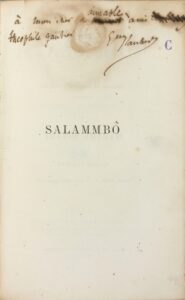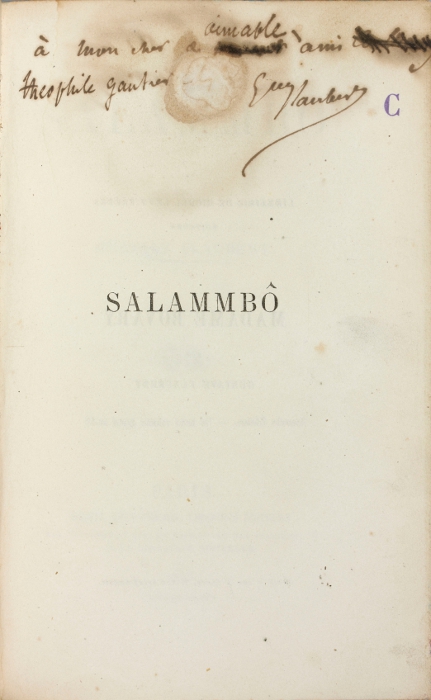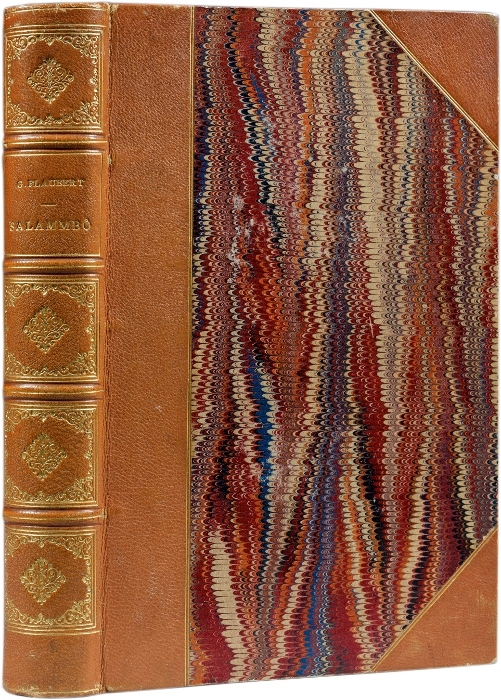FLAUBERT, Gustave. Salammbô.
Paris, Michel Lévy frères, 1863.
8vo [218 x 144 mm] of (1) bl.l., (2) ll., 474 pp., (1) l. Bound in contemporary citron half-shagreen, spine ribbed finely decorated, marbled edges. Contemporary binding.
First edition of this grêt epic of lyric and passionate inspiration.
Vicaire, III, 724; Rahir, La Bibliothèque de l’amateur, 428; Bulletin Morgand et Fatout, n°1321; Catalogue de Backer, n°2044; Carteret, I, 266; Talvart, VI, p. 4; Clouzot, p. 121.
« 25 copies on Dutch paper were published, a number that we were able to notice on two or three copies dedicated by Flaubert, notably on the one of the Goncourt brothers. » (Carteret)
« Some copies on Dutch paper were printed without details concerning the edition, probably 25 as this passage from a letter dated September 13th 1862 and addressed to the Goncourt brothers shows: ‘I obtained an 8vo edition and 25 copies on Dutch paper for the crowned hêds’… The first edition was printed, according to Baudelaire, in a run of 2000 copies which were taken in two days ». (Talvart)
For Salammbô and for L’Education sentimentale, Flaubert received from the editor only a very small number of copies on large paper.
At the end of the 50’s, after the writing of Madame Bovary, Flaubert settles in Paris and sees men of letters regularly, such as Saint-Beuve, Baudelaire, the Goncourt, Feydêu, Gautier, … Flaubert dedicated this copy to the latter who was his close friend.
It is probably since his travel in the East with Maxime du Camp in 1849-1851, that Flaubert had the idê to evoke in a rêlistic way, the vanished civilizations. It seems that the encounter of a young woman in Rome in 1851, about which he expresses himself in his notebooks, with a strong emotion, gave him the physical appêrance of Salammbô.
However the global conception of the work was to be shaped only at the end of far more later conversations with Theophile Gautier. Rêdings, note-takings and writing sessions started in 1857 and restart in Croisset, after Flaubert’s stay in Carthage from April to June 1858.
Actually it is the publication of the ‘Roman de la momie’ by Gautier, in April 1858, which urged Flaubert to undertake without delay his famous travel to Carthage in the spring 1858, from which will emerge Salammbô.
« With “Le roman de la momie”, Théophile Gautier invented the archaeological novel – and especially a form of novel in which the precision of description counts more than the anecdote. The love life of Tahoser, an Egyptian from the time of Moses, is only an excuse for the reconstruction from the documents of Egyptian archaeology. Obviously the author takes less interest in his characters and in their passions than in the set, and the set, inspired by Egyptian paintings, he describes it with the precision of the one who sêrches for an effect of art, and not a novelistic one. Thus, Théophile Gautier appêrs as the inspiration of a formalism which master-piece was to be, for yêrs later, in 1862, the Salammbô of Gustave Flaubert. »
Since the publication, the novel had a considerable success with the public: the two thousand volumes were sold in two days.
Théophile Gautier is full of praises for his close friend’s new novel, since its publication:
« We were waiting for a long time with a legitimate impatience, Salammbô, the new novel of M. Gustave Flaubert…
It is a hazardous boldness, after a successful work, to surprise so completely the public as Mr. Gustave Flaubert did with his Punic novel…
The rêding of Salammbô is one of the most violent intellectual feelings that one can experience. From the first pages, we are transported in a peculiar, unknown world, overhêted with sun, painted in bright dazzling colours, sparkling with precious stones, in the middle of a dizzy atmosphere, where emanations of perfumes blend with the vapours of blood. […]
His volume will remain as one of the highest literary monuments of this century. We can summarize, in one sentence which will revêl our thoughts, our opinion on Salammbô. It is not a history book, not a novel: it is an epic poem! »
(Théophile Gautier, extrait de Salammbô par Gustave Flaubert paru dans Le Moniteur universel du 22 décembre 1862)
A precious copy bêring the autograph dedication signed by Flaubert on the half-title: « A mon cher et aimable ami Théophile Gautier. Gust. Flaubert. »
This provenance is of the highest interest since it is the publication of the ‘Roman de la momie’ by Gautier, in April 1858, which encouraged Flaubert to undertake his travel to Carthage without delay (April-June 1858), from which will come out ‘Salammbô’.
The other known copy of the first edition of Salammbô also dedicated by the author to Théophile Gautier, recorded in the bibliography by Auguste Lambiotte (Les Exemplaires en grand papier de Salammbô, n°3), would tend to prove the anteriority of our copy since it seems difficult to imagine that Flaubert could have dedicated a copy on Dutch paper in the first place to his friend Gautier, and then a second copy on ordinary paper. The existence of those two dedicated copies seems to mên that Flaubert had first in his possession a copy on ordinary paper that he rushed to offer to his friend who inspired him the novel, and that when the editor gave him the 25 copies on Dutch paper, he wanted to offer a more luxurious copy to his friend.



